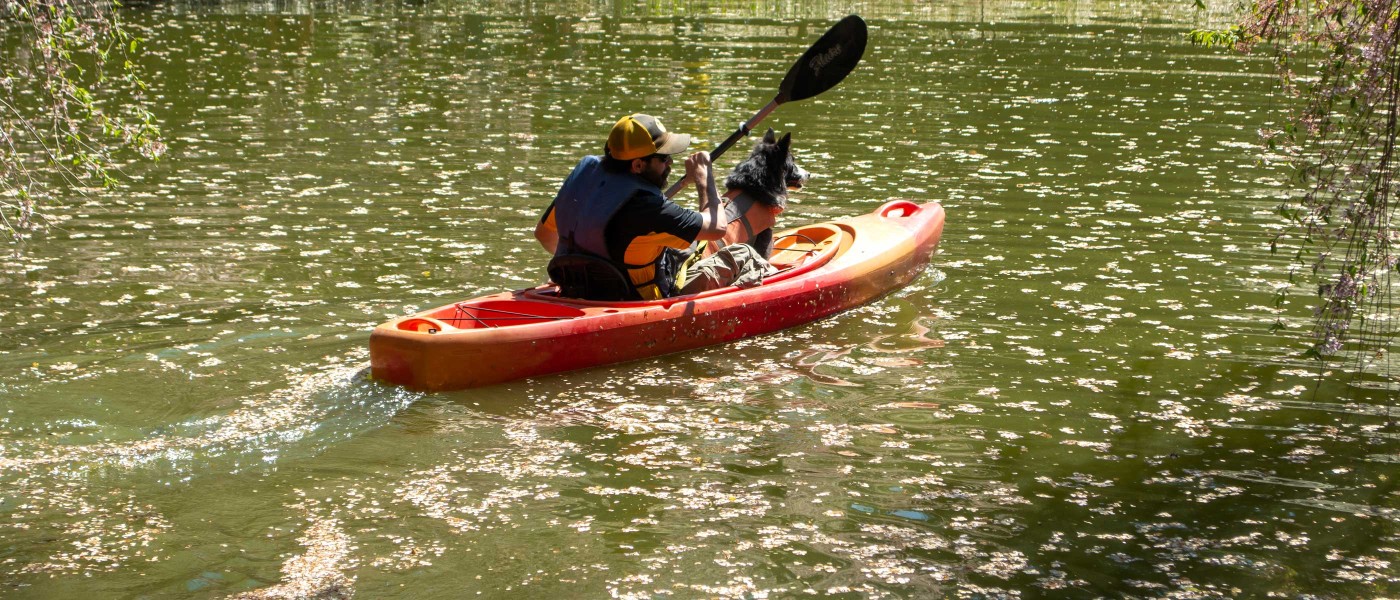Why Are Dogs Chasing Geese in the Garden?
If you’re visiting Brooklyn Botanic Garden between now and early June, you may notice a border collie running (or, in some cases, kayaking) after a flock of Canada geese. So, what’s this all about?
The collies are working with a handler to encourage Canada geese to leave the area. They are well-trained, don’t bark, and do not make physical contact with the geese or with visitors. We’ve answered some frequently asked questions below.
What’s the problem?
When large flocks of Canada geese spend time in the Garden, they poop everywhere—one Canada goose can produce up to two pounds of droppings per day.
In addition to causing a mess, goose droppings add nutrients to bodies of water that can damage aquatic habitats and promote harmful algal blooms. Canada geese also graze on plantings and can trample early-spring vegetation and damage aquatic plants. On rare occasions, when protecting nests or goslings, they can become aggressive toward people.
What’s the solution?
For the past few years, Brooklyn Botanic Garden has brought border collies on site as an aversion tactic, following management guidance from Cornell Cooperative Extension. The use of “geese-herding” collies is increasingly common in urban green spaces, and comes recommended as a humane geese management tool by the Humane Society of the U.S. and PETA.
Geese view border collies as predators and will flee when approached. Federal law bars dogs from catching or physically harming the birds; the aim is for the geese to learn that the area is unsafe and move on to a more suitable site. A major goal is to prevent nesting pairs from laying eggs here. Geese who have nested here will continue to return indefinitely.
How does this work?
A dog and a handler visit the Garden regularly and may continue to do so through the end of the nesting period, which lasts from March until June. The pair, accompanied by Garden staff, check sites favored by the geese—typically the Japanese Garden, Cherry Esplanade, and the area around the Water Garden. The collie approaches the geese (sometimes as a passenger in a kayak) and the geese fly off.
Tell me more about Canada geese. Are they endangered?
No, they are considered a species of “Least Concern” by the International Union for Conservation of Nature. Canada geese are an iconic and charismatic species, and many Garden visitors and staff are fond of them. Populations in New York are a mix of migratory and resident subspecies, the latter of which are most abundant and most frequently associated with “nuisance situations” in the state, according to the New York State Department of Environmental Conservation.
Canada geese were once critically endangered. By around 1900, European colonizers had overhunted the waterfowl to near-extinction and drained their wetland habitats.
Thanks to strict conservation measures, coupled with the species’ ability to thrive in urban and suburban areas, their populations dramatically rebounded. Captive breeding and relocation efforts helped lead to new resident subspecies that no longer migrate. There are now an estimated seven million Canada geese living in North America, a population boom that has been accompanied by human-wildlife conflicts (and, in some cases, habitat degradation).
Where can I learn more about this?
For more information, check out The Humane Society’s Canada geese management plan. In the popular press, The Atlantic published a 2022 piece exploring conflicts around Canada geese.
Additional info is available from the New York State Department of Environmental Conservation, Cornell Cooperative Extension, and the National Audubon Society.


